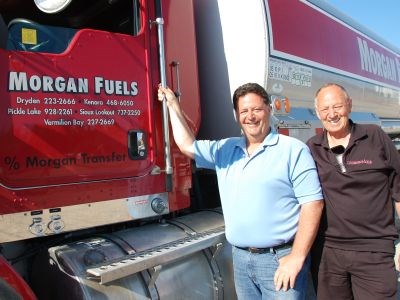Lew Morgan gets misty-eyed when he's asked about the expanding size and scope of his family-owned northwestern Ontario trucking firm that has passed to a third generation.
“I'm pretty pleased,” he said in halting voice of his son, Darrell. “Very happy.”
At 70 years old and working “semi-retired” hours from 7:30 a.m. until 5 p.m., Lew will occasionally jump behind the wheel of a tanker truck to make a delivery if there's a shortage of drivers.
“I'm still here, it's in my blood.”
With 38 full-time employees and a fleet of 30 vehicles and trailers delivering fuel products across northwestern Ontario and southern Manitoba, the workforce at the Morgan Group of Companies almost doubles during the busy winter road-haul season.
The Sioux Lookout-based carrier of Esso fuel products has come a long way from when Lew operated a one-tanker truck division for his father, Ebenezer Morgan, who started the company in 1935 hauling for British American Oil.
Through acquisition, Darrell has broadened the company's coverage area to begin servicing the Aboriginal communities north of Sioux Lookout and Pickle Lake.
“Darrell just took the reigns and really ran with it,” said Lew of his son's expansion plans that included signing a joint venture agreement with the Wasaya Group last fall.
Wasaya, a Thunder Bay-based Native venture corporation, signed the business partnership with Morgan in October after years of building a solid relationship with owners Darrell and Anne Morgan.
Morgan has the fuel haul contract for Wasaya for more than four years, bringing shipments into the Aboriginal communities which are accessible by land only during the winter months.
With mineral development in the James Bay lowlands poised to take off, the opportunities to haul more freight is only expected to grow.
The two parties have created Ohteban LP (an Oji-Cree word for 'truck') that's being added to Wasaya's stable of companies and not-for-profit interests in aviation, petroleum, storage and contracting.
For both entities, it was a strategic move for the anticipated development boom that will start with constructing all-season roads into the First Nation communities that will serve future mines in the Ring of Fire in the James Bay Lowlands.
Wasaya president Tom Kamenawatamin said there's always been a level of comfort in working with the Morgan Group as a safe and reliable carrier during the short, pressure-packed, winter road season.
“It was always difficult to have enough trucks to do the job in that short period of time. That's when we started talking with Darrell who had experience in the winter road haul.”
After the first couple of years working for Wasaya, with no complaints coming back from customers, Kamenawatamin said that's when joint venture talks began.
“He always had his equipment ready and available, he knew how to keep track of road conditions and he had strategies for where he should take the fuel at the right time.”
If the Ring of Fire unfolds as advertised, a single mine operation in the Far North, Kamenawatamin said, could require as many as 100 haul trucks a day, representing about 400 drivers and support jobs. Plus, there will be opportunities to haul construction material and fuel products for any supporting road or rail development.
The joint venture also includes an Aboriginal training plan to produce a future workforce of drivers, mechanics and managers.
“That's where we're heading this summer, strategizing about how we're going to move forward on the training,” said
Kamenawatamin. “Right now we're just on the fuel haul, but in a year or two we want to be on the highway as well.”
“The opportunities are endless, specifically with the Ring of Fire,” said Darrell. “There's also huge opportunities for people from the communities up North to get involved, and it's about harnessing some of the skill sets there. There are lots of young people and they're all going to need jobs.”
Wasaya currently has a 12-per-cent stake in the joint venture which allows for a structured buyout down the road, a subject of future negotiations with Darrell, said Kamenawatamin.
“It takes time for us to train our own First Nations people to take over companies, but we've been through that and we know the process. We need to have the right people identified for that.”
Nevertheless, he's anxious to move forward in his discussions with the miners.
While Ring of Fire miners like Cliffs Natural Resources and Noront Resources appear to be wedded to a north-south transportation corridor through Nakina, instead of running west to an existing road system at Pickle Lake, both Kamenawatamin and Darrell are undaunted, maintaining that their goal is to be a preferred carrier catering to the mine developments.
“We'll go wherever the roads are,” said Darrell. “One of the things we want to make sure is that our joint venture gets to capitalize on any of those opportunities.
How that all comes together in terms of a road or rail access corridor, nobody knows yet.”




